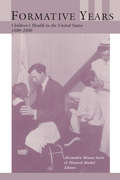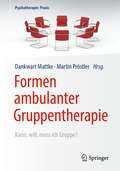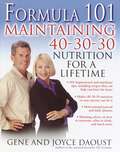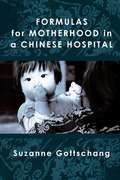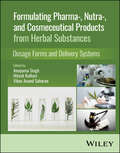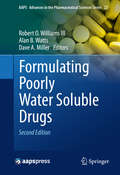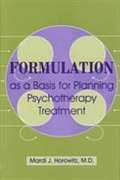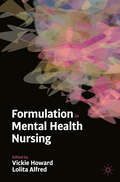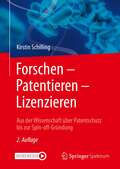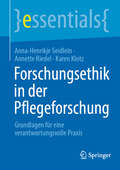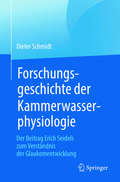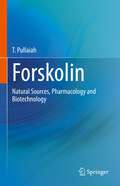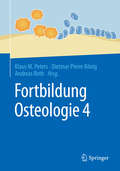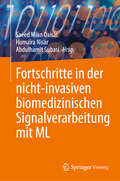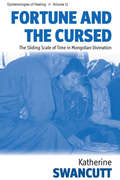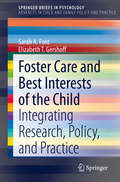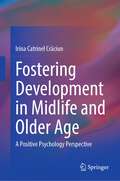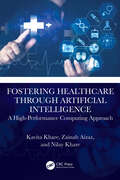- Table View
- List View
Formative Years: Children's Health in the United States, 1880-2000
by Howard Markel Alexandra Minna SternAlexandra Minna Stern is Associate Director of the Center for the History of Medicine and Assistant Professor of Obstetrics and Gynecology and American Culture at the University of Michigan. Howard Markel is the George Edward Wantz Professor of the History of Medicine, Professor of Pediatrics and Communicable Diseases, and Professor of History at the University of Michigan, and Director of the Center for the History of Medicine.
Formen ambulanter Gruppentherapie: Kann, will, muss ich Gruppe? (Psychotherapie: Praxis)
by Dankwart Mattke Martin PröstlerDieses Buch ist ein Plädoyer für Gruppenangebote in der ambulanten psychotherapeutischen Praxis. Es versammelt Grundlagen, Erfahrungen und Praxistipps für Gruppen in verschiedenen Settings, Patientengruppen und Therapieschulen und leistet einen Beitrag zur Debatte um die patientenorientierte Versorgung. Psychologische und ärztliche Psychotherapeuten sowie Psychiater erfahren, wie sie Gruppenpsychotherapie nach den Richtlinienverfahren für ihre ambulante Praxis neu entdecken, gestalten und ausbauen können. Gruppenpsychotherapien erlauben eine lebendige, bereichernde und ökonomische Anwendung von Psychotherapie bei einer Vielzahl von Problemfeldern und Störungen und sind im Hinblick auf ihre Wirksamkeit sehr gut abgesichert. Aus dem Inhalt: Psychodynamische Psychotherapie in Gruppen – Verhaltenstherapie in Gruppen – Kinder- und Jugendlichenpsychotherapie in Gruppen – Kombination von Einzel- und Gruppenpsychotherapie – Gruppenpsychotherapie in der ambulanten Rehabilitation – Praxisorganisation und Abrechnung – Stand der Forschung. Die Herausgeber: Dr. med. Dankwart Mattke ist in fachärztlicher Praxis tätig: psychosomatische Medizin, Psychiatrie, Neurologie, Psychotherapie, Psychoanalyse; zudem in eigener Beratungssozietät: Supervision, Coaching, Training, Organisations- und Teamentwicklung. Dipl.-Psych., Dipl.-Theol. Martin Pröstler ist Psychoanalytiker und Gruppenlehranalytiker, niedergelassen als Psychotherapeut, Supervisor und Organisationsberater in eigener Praxis.
Formula 101: Maintaining 40-30-30 Nutrition for a Lifetime
by Gene Daoust Joyce DaoustThe must-have companion to the national bestseller The Formula. What is the 40-30-30 formula? It's the exact combination of carbohydrates, proteins, and fats you need to eat at every meal to stimulate the production of glucagon--the body's natural fat-burning hormone. If you're eating breakfast, lunch, and dinner on the 40-30-30 formula, your fat is melting away and your energy and concentration are at peak performance. Now with Formula 101, Gene and Joyce Daoust have written a fun, fact-filled companion to the original book that is essential to help you keep right on track in your fight against the pounds. Simple and straightforward, this book gives you: * 101 simple nutrition tips and secrets guaranteed to help you burn fat faster and stay with The Formula for life, including delicious recipes * The Formula Nutrition Journal--a self-motivational personal nutrition journal and daily planner to help you continue to eat right * Helpful suggestions for eating out on The Formula--from fast food to haute cuisine, even dessert--you can still enjoy restaurants on the 40-30-30 plan. Formula 101 is the ultimate guide for anyone who wants to continue to lose weight, feel great, and perform better. In your hands are all the tools you need to master the 40-30-30 way of eating--starting today!
Formulas for Motherhood in a Chinese Hospital
by Suzanne GottschangWhat happens to pregnant women when the largest country in the world implements a global health policy aimed at reorganizing hospitals and re- training health care workers to promote breastfeeding? Since 1992, the Chinese government has led the world in reorganizing more than 7,000 hospitals into “Baby- Friendly” hospitals. The initiative’s goal, overseen by UNICEF and the World Health Organization, is to promote the practice of breastfeeding by reorganizing hospital routines, spaces, and knowledge in maternity wards and obstetrics clinics. At the same time, China’s hospitals in the mid- 1990s operated as sites where the effects of economic reform and capitalism increasingly blurred the boundaries between state imperatives to produce healthy future citizens and the flexibility accorded individuals through their participation in an emerging consumer culture. Formulas for Motherhood follows a group of women over eighteen months as they visited a Beijing Baby- Friendly Hospital over the course of their pregnancies and throughout their postpartum recoveries. The book shows how the space of the hospital operates as a microcosm of the larger social, political, and economic forces that urban Chinese women navigate in the process of becoming a mother. Relations between biomedical practices, heightened expectations of femininity and sexuality demanded by a consumer culture, alongside international and national agendas to promote maternal and child health, reveal new agents of maternal governance emerging at the very moment China’s economy heats up. This ethnography provides insight into how women’s creative pragmatism in a rapidly changing society leads to their views and decisions about motherhood.
Formulas, Ingredients and Production of Cosmetics
by Hiroshi Iwata Kunio ShimadaToday, young cosmetics researchers who have completed their graduate studies and have entered a cosmetics company are put through several years of training before they become qualified to design cosmetics formulations themselves. They are trained so that they can design formulas not by a process of logic but by heart, like craftsmen, chefs, or carpenters. This kind of training seems a terrible waste of labor and time. To address this issue and allow young scientists to design novel cosmetics formulations, effectively bringing greater diversity of innovation to the industry, this book provides a key set of skills and the knowledge necessary for such pursuits. The volume provides the comprehensive knowledge and instruction necessary for researchers to design and create cosmetics products. The book's chapters cover a comprehensive list of topics, which include, among others, the basics of cosmetics, such as the raw materials of cosmetics and their application; practical techniques and technologies for designing and manufacturing cosmetics, as well as theoretical knowledge; emulsification; sensory evaluations of cosmetic ingredients; and how to create products such as soap-based cleansers, shampoos, conditioners, creams, and others. The potential for innovation is great in Japan's cosmetics industry. This book expresses the hope that the high level of dedicated research continues and proliferates, especially among those who are innovators at heart.
Formulating Pharma-, Nutra-, and Cosmeceutical Products from Herbal Substances: Dosage Forms and Delivery Systems
by Anupama Singh Vikas Anand Saharan Hitesh KulhariA practical and up-to-date discussion of the formulation and design of dosage forms and delivery systems containing herbal ingredients In Formulating Pharma-, Nutra-, and Cosmeceutical Products from Herbal Substances: Dosage Forms and Delivery Systems, a team of distinguished researchers delivers a step-by-step approach to preparing and manufacturing dosage forms and delivery systems. Intuitively organized with comprehensive coverage of the fundamentals, functional materials, manufacturing, and marketing of pharmaceutical, nutraceutical, and cosmeceutical products, the book also examines regulatory issues of quality, safety, and efficacy. The authors discuss essential formulation development and delivery information for novel and controlled delivery systems of herbal ingredients. Readers will also find: A thorough introduction to the basic principles of developing modern pharma-, nutra-, and cosmeceutical products from herbal substancesComprehensive explorations of conventional formulations, including issues of stabilityPractical discussions of advanced formulations, including chronotherapeutic delivery systems, liposome-based delivery of phytoconstituents, and nanoparticle mediated delivery of herbal activesComplete treatments of regulatory challenges, including nonclinical characterization and documentation for marketing authorizations of herbal formulations Perfect for professionals working in the herbal drug, natural product, and dietary supplement industries, Formulating Pharma-, Nutra-, and Cosmeceutical Products from Herbal Substances will also benefit academic researchers and graduate students studying herbal research, cosmetics, and pharmaceutical sciences.
Formulating Poorly Water Soluble Drugs
by Robert O. Williams III Alan B. Watts Dave A. MillerThis volume is intended to provide the reader with a breadth of understanding regarding the many challenges faced with the formulation of poorly water-soluble drugs as well as in-depth knowledge in the critical areas of development with these compounds. Further, this book is designed to provide practical guidance for overcoming formulation challenges toward the end goal of improving drug therapies with poorly water-soluble drugs. Enhancing solubility via formulation intervention is a unique opportunity in which formulation scientists can enable drug therapies by creating viable medicines from seemingly undeliverable molecules. With the ever increasing number of poorly water-soluble compounds entering development, the role of the formulation scientist is growing in importance. Also, knowledge of the advanced analytical, formulation, and process technologies as well as specific regulatory considerations related to the formulation of these compounds is increasing in value. Ideally, this book will serve as a useful tool in the education of current and future generations of scientists, and in this context contribute toward providing patients with new and better medicines.
Formulating Poorly Water Soluble Drugs
by Alan B. Watts Dave A. Miller Robert O. WilliamsThe objective of this volume is to consolidate within a single text the most current knowledge, practical methods, and regulatory considerations pertaining to formulations development with poorly water-soluble molecules. A pharmaceutical scientist's approach toward solubility enhancement of a poorly water-soluble molecule typically includes detailed characterization of the compound's physiochemical properties, solid-state modifications, advanced formulation design, non-conventional process technologies, advanced analytical characterization, and specialized product performance analysis techniques. The scientist must also be aware of the unique regulatory considerations pertaining to the non-conventional approaches often utilized for poorly water-soluble drugs. One faced with the challenge of developing a drug product from a poorly soluble compound must possess at minimum a working knowledge of each of the abovementioned facets and detailed knowledge of most. In light of the magnitude of the growing solubility problem to drug development, this is a significant burden especially when considering that knowledge in most of these areas is relatively new and continues to develop
Formulating Poorly Water Soluble Drugs (AAPS Advances in the Pharmaceutical Sciences Series #50)
by Robert O. Williams III Dave A. Miller Daniel A. Davis Jr.The objective of this third edition is to consolidate within a single text the most current knowledge, practical methods, and regulatory considerations pertaining to formulations development with poorly water-soluble molecules. A pharmaceutical scientist’s approach toward solubility enhancement of a poorly water-soluble molecule typically includes detailed characterization of the compound’s physiochemical properties, solid-state modifications, advanced formulation design, non-conventional process technologies, advanced analytical characterization, and specialized product performance analysis techniques. The scientist must also be aware of the unique regulatory considerations pertaining to the non-conventional approaches often utilized for poorly water-soluble drugs. One faced with the challenge of developing a drug product from a poorly soluble compound must possess at a minimum a working knowledge of each of the above mentioned facets and detailed knowledge of most. In light of the magnitude of the growing solubility problem to drug development, this is a significant burden especially when considering that knowledge in most of these areas is relatively new and continues to develop.
Formulating a Differential Diagnosis: For the Advanced Practice Provider
by Jacqueline Rhoads Julie C. PenickThis easy-access clinical guide to over 70 commonly seen symptoms, written for advanced practice provider (APP) students and new practitioners, describes a step-by-step process for obtaining a reliable patient history, choosing the appropriate physical exam, and using the patient history and physical exam findings to form a differential diagnosis. <p><p>The second edition continues to include the case study approach, and is updated to incorporate 22 new symptoms along with contributions by a new editor, who is a leader in holistic health. <p><p> The guide is distinguished by several unique features including focused patient history questions and responses, physical exam findings, a differential diagnosis table (clearly comparing potential diagnostic choices based on symptoms), a diagnostic examination table (including estimated costs and codes), and a case study summary highlighting the critical thinking process. Symptoms are presented alphabetically in a systematic, unfolding case study approach and include chief complaint, presenting history, past history, and explicit methodology for determining correct diagnosis.
Formulation As A Basis For Planning Psychotherapy Treatment
by Mardi J. HorowitzTo help their patients, clinicians must make accurate diagnoses and devise effective treatment plans. These plans often involve psychotherapy with goals that include symptom reduction, the prevention of relapse, and helping patients recognize and remove impediments to more effective functioning. Formulation as a Basis for Planning Psychotherapy Treatment presents a formulation system that combines concepts derived from psychodynamic, interpersonal, cognitive-behavioral, and family system approaches. In a step-by-step manner, illustrated by plentiful case examples, this useful guide shows psychiatrists, residents in psychiatry and psychology, social workers, and marriage and family counselors how to plan treatment after the initial diagnosis. After an overview of psychological change processes, each of the five steps in the formulation process are covered systematically. Case formulation is begun by the careful selection and description of a patient's symptoms and problems. This information is then grouped into states of mind, an approach that allows for multiple presentations of a patient, avoids static descriptions of observations, and places many observable features into meaningful clusters of co-occurrence. Subsequent chapters explain how all of this information can be used to focus the treatment and identify defensive controls that may interfere with treatment. The author describes how to infer deep beliefs about the self in terms of views of relationships with others. The book teaches how to formulate plans for interventions during psychotherapy.
Formulation in Mental Health Nursing
by Vickie Howard Lolita AlfredThis book offers a comprehensive overview of formulation applied within the mental health nursing context. It presents a contemporary outlook on the role of the mental health nurse, exploring and reflecting on the foundational values-based and person-centred principles of mental health nurse education and practice. Through this timely and accessible textbook, the authors demonstrate how a variety of theories can be used to enhance formulation in practice, ensuring mental health assessment and intervention are meaningfully connected to support patient recovery. Including service user experiences and viewpoints throughout, each chapter also benefits from tailored discussion points to enable learners to develop critical thinking around formulation. An invaluable guide to the field, it provides a clear, up to date and thought-provoking overview of formulation, essential for students and practitioners in clinical psychology or psychotherapy, as well as clinicians working in all areas of mental health and social care, psychology, therapy, and counselling.
Forschen – Patentieren – Lizenzieren: Aus der Wissenschaft über Patentschutz bis zur Spin-off-Gründung
by Kirstin SchillingDieser Ratgeber erklärt, wie Forschungsergebnisse aus Universitäten und Hochschulen patentiert und lizenziert oder verkauft werden können. Wichtige Aspekte des Erfindungs-, Patent- und Lizenzrechts werden anhand von Beispielen erläutert.Im ersten Teil werden Fragen beantwortet, was eine patentierbare Erfindung ist und welche Erfindervergütung Forschenden an Hochschulen zusteht. Ausführlich behandelt wird u.a. das Thema, wie Forschungsergebnisse publiziert und trotzdem patentiert werden können.Im zweiten Teil, speziell zum Patentieren, wird gezeigt, wie eine Patentanmeldung aufgebaut ist, wie Patentprüfverfahren ablaufen und was sie kosten. Mit vielen Praxistipps wird erklärt, wie man eine Patentrecherche durchführt und ermittelt, ob ein Patent noch aktiv ist. Zudem wird erläutert, welche Besonderheiten beim Schutz von Erfindungen für medizinische Anwendungen zu beachten sind.Im dritten Teil werden verschiedene vertragliche Lösungen zur Anbahnung sowie zum Abschluss von Lizenz- und anderen Verwertungsvereinbarungen vorgestellt. Häufige Probleme bei der Finanzierung der Weiterentwicklung von Projekten werden adressiert und Lösungen aufgezeigt. Der Schlussteil ist speziell dem Thema der Gründung von akademischen Spin-off-Unternehmen gewidmet. Die aktualisierte und erweiterte 2. Auflage enthält neue Beiträge zu den Themen Software-Schutz und -Lizenzierung und zu den Möglichkeiten, patentgeschützte Technologien weiterzuentwickeln. Neue Beispiele sowie verlinkte Interviews mit Experten illustrieren Best-practice-Fälle.Das Buch eignet sich sowohl als Übersicht für Einsteiger als auch zum gelegentlichen Nachschlagen für gestandene Erfinder. Es richtet sich grundsätzlich an alle Forschenden in den Naturwissenschaften und der Medizin sowie Mitarbeitende des Technologietransfers an Universitäten, Universitätskliniken und Hochschulen. Videos per App: einfach die SN More Media App kostenfrei herunterladen, ein Bild oder einen Link mit dem Play-Button scannen und sofort das Video auf Smartphone oder Tablet ausspielen.
Forschungsethik in der Pflegeforschung: Grundlagen für eine verantwortungsvolle Praxis (essentials)
by Annette Riedel Anna-Henrikje Seidlein Karen KlotzPflegeforschung ist für eine professionelle, sichere und qualitativ hochwertige Pflege unverzichtbar. Dabei spielen forschungsethische Fragen eine zentrale Rolle. Forschende in der Pflege und daran beteiligte Pflegefachpersonen müssen forschungsethische Anforderungen vorausschauend und fortlaufend reflektieren und ethische Standards einhalten. Forschungsethik ermöglicht es, die Verantwortung der Forschenden mit den unterschiedlichen Vulnerabilitäten der Forschungsteilnehmenden in Einklang zu bringen und die Würde und Rechte der beteiligten Personen zu schützen. Das Buch bietet eine Einführung in die Methoden und Strukturen der Forschungsethik.
Forschungsgeschichte der Kammerwasserphysiologie: Der Beitrag Erich Seidels zum Verständnis der Glaukomentwicklung
by Dieter SchmidtEnde des 19. und zu Beginn des 20. Jahrhunderts gab es sehr unterschiedliche experimentelle Befunde zur Physiologie der Kammerwasserwege. Mit seinen Untersuchungen zeigte Erich Seidel, dass der Ziliarkörper das Sekretionsorgan des Auges ist. Seine bedeutenden zahlreichen und umfangreichen Publikationen, die sich mit Fragen der intraokularen Flüssigkeitsströmung und mit dem Glaukom befassten, erschienen in der Zeit von 1916 bis 1932. Mit seinen neuen Erkenntnissen setzte er sich trotz Widerspruchs mehrerer Augenärzte durch und trug damit entscheidend zum besseren Verständnis der Glaukomentwicklung bei.
Forschungsmethoden in der Gesundheitsförderung und Prävention
by Marlen Niederberger Emily FinneUm als Schnittstelle zwischen Wissenschaft und Praxis geeignete Interventionen zu identifizieren, zu entwickeln, umzusetzen und zu evaluieren, benötigen Gesundheitsförderung und Prävention unter anderem Theorien, eine zuverlässige Evidenzlage, aktuelle empirische Daten, subjektorientierte Ansätze und partizipative Instrumente. In diesem Kontext spielen qualitative und quantitative Forschungsmethoden sowie inter- und transdisziplinäre Sichtweisen eine wichtige Rolle. Dieses Buch gibt einen Überblick über wichtige Forschungsmethoden in der Gesundheitsförderung und Prävention.
Forskolin: Natural Sources, Pharmacology and Biotechnology
by T. PullaiahThis monograph compiles updated information about forskolin, a labdane diterpene that is produced by the Coleus plant. Forskolin has a large number of practical uses and the book delves into the various aspects of this chemical. It includes topics such as the botanical source of forskolin and the cultivation of Coleus forskohlii, source. It also covers the biosynthetic pathways in natural sources and also through different biotechnological applications. Chapters include the potential and products in the Forskolin market. The book also covers the methods for enhanced production of forskolin from natural sources and through tissue culture methods for improvement of the plant for higher content of forskolin. It discusses the role of endophytes in the production of forskolin.The book is useful for students and researchers in the field of botany, pharmacology and biochemistry. It also serves scientists in various pharmaceutical industries.
Fortbildung Osteologie 4 (Fortbildung Osteologie Ser. #4)
by Andreas Roth Klaus M. Peters Dietmar Pierre KönigDie Bände aus der Buchreihe „Fortbildung Osteologie“ beruhen auf den Inhalten der regelmäßig durchgeführten osteologischen Seminare der Sektion Osteologie der Deutschen Gesellschaft für Orthopädie und Orthopädische Chirurgie (DGOOC) zu ausgewählten Schwerpunkthemen. Konzipiert ist die Reihe für alle zukünftigen Osteologen und für Fachärzte, die sich schon zum Osteologen DVO zertifiziert haben.Für die „Fortbildung Osteologie IV“ wurden Themen ausgewählt, bei denen es in den letzten Jahren relevante Innovationen in Bezug auf Klinik, Diagnostik oder Therapie gab.
Fortschritte der Chemie organischer Naturstoffe / Progress in the Chemistry of Organic Natural Products, Vol. 92
by A. Douglas Kinghorn Herbert Budzikiewicz Heinz Falk Rogelio Pereda-Miranda Daniel Rosas-Ramírez Junichi Kobayashi Jhon Castañeda-GómezThe volumes of this classic series, now referred to simply as "Zechmeister" after its founder, L. Zechmeister, have appeared under the Springer Imprint ever since the series' inauguration in 1938. The volumes contain contributions on various topics related to the origin, distribution, chemistry, synthesis, biochemistry, function or use of various classes of naturally occurring substances ranging from small molecules to biopolymers. Each contribution is written by a recognized authority in his field and provides a comprehensive and up-to-date review of the topic in question. Addressed to biologists, technologists, and chemists alike, the series can be used by the expert as a source of information and literature citations and by the non-expert as a means of orientation in a rapidly developing discipline.
Fortschritte in der nicht-invasiven biomedizinischen Signalverarbeitung mit ML
by Abdulhamit Subasi Saeed Mian Qaisar Humaira NisarDieses Buch präsentiert Fortschritte in der biomedizinischen Technologie. IoT und Machine Learning haben neue Ansätze im mobilen Gesundheitswesen ermöglicht, mit Fokus auf kontinuierlicher Überwachung kritischer Gesundheitssituationen. Intelligente Hybridisierung von IoT, drahtlosen Implantaten und Cloud-Computing wird derzeit von verschiedenen Einrichtungen entwickelt und getestet. Biomedizinische Signale und Bildmodalitäten werden nicht-invasiv erfasst und erfordern eine mehrkanalige Erfassung für wirksame Überwachung. Automatisierte Gesundheitssysteme basieren auf Signal- und Bildaufnahme, Vorverarbeitung, Merkmalsextraktion und Klassifikation. Das Buch beschreibt zeitgenössische Ansätze in der biomedizinischen Signalerfassung und -verarbeitung mit maschinellem und tiefem Lernen. Jedes Kapitel ist eigenständig und bietet eine umfassende Übersicht über Theorien, Algorithmen und Herausforderungen im Bereich moderner Gesundheitssysteme.
Fortschritte in der speziellen Hüftchirurgie
by Kyung-Hoi Koo Wolf R. Drescher Russell E. WindsorDieses Buch beschreibt aktuelle und neue Techniken in der Hüftchirurgie und vermittelt das wesentliche, aktuelle Wissen, das der orthopädische Chirurg benötigt, der sich auf die Hüfte spezialisieren will. Das Eröffnungskapitel bietet einen prägnanten Überblick über die chirurgische Anatomie, mit besonderem Augenmerk auf Details, die für die im Buch beschriebenen Operationstechniken relevant sind. Anschließend werden der zunehmend beliebte anteriore minimalinvasive Zugang zur Hüfte und eine mikroinvasive Variante dieses Zugangs beschrieben. In den folgenden Kapiteln werden chirurgische Ansätze für Entwicklungsstörungen der Hüfte, einschließlich Dysplasie und femoroacetabulärem Impingement, sowie vielversprechende Techniken zur Erhaltung der Hüfte bei avaskulärer Nekrose der Hüfte vorgestellt - eine oft vernachlässigte, aber international relevante Krankheit, die die Hüfte bei jungen Patienten verstümmeln kann. Schließlich werden die neuesten Techniken und Implantate für die Primär- und Revisionshüftprothetik eingehend erörtert. Das internationale Autorenteam besteht aus anerkannten Fachleuten auf diesem Gebiet, von denen viele die beschriebenen Klassifizierungen und neuen Operationstechniken entwickelt haben
Fortune And The Cursed
by Katherine SwancuttInnovation-making is a classic theme in anthropology that reveals how people fine-tune their ontologies, live in the world and conceive of it as they do. This ethnographic study is an entrance into the world of Buryat Mongol divination, where a group of cursed shamans undertake the 'race against time' to produce innovative remedies that will improve their fallen fortunes at an unconventional pace. Drawing on parallels between social anthropology and chaos theory, the author gives an in-depth account of how Buryat shamans and their notion of fortune operate as 'strange attractors' who propagate the ongoing process of innovation-making. With its view into this long-term 'cursing war' between two shamanic factions in a rural Mongolian district, and the comparative findings on cursing in rural China, this book is a needed resource for anyone with an interest in the anthropology of religion, shamanism, witchcraft and genealogical change.
Foster Care and Best Interests of the Child: Integrating Research, Policy, and Practice (SpringerBriefs in Psychology)
by Elizabeth T. Gershoff Sarah A. FontThis brief examines the U.S. foster care system and seeks to explain why the foster care system functions as it does and how it can be improved to serve the best interest of children. It defines and evaluates key challenges that undermine child safety and well-being in the current foster care system. Chapters highlight the competing values and priorities of the system as well as the pros and cons for the use of foster care. In addition, chapters assess whether the performance objectives in which states are evaluated by the federal government are sufficient to achieve positive health and well-being outcomes for children who experience foster care. Finally, it offers recommendations for improving the system and maximizing positive outcomes. Topics featured in this brief include: Legal aspects of removal and placement of children in foster care.The effectiveness of prior efforts to reform foster care.The regulation and quality of foster homes.Support for youth aging out of the foster care system.Racial and ethnic disparities in the foster care system. Foster Care and the Best Interests of the Child is a must-have resource for policy makers and related professionals, graduate students, and researchers in child and school psychology, family studies, public health, social work, law/criminal justice, and sociology.
Fostering Development in Midlife and Older Age: A Positive Psychology Perspective
by Irina Catrinel CrăciunThis handbook integrates and discusses a growing evidence base concerning individual development across middle and late adulthood. The book includes a comprehensive analysis of what growth implies within midlife and older age and considers how different developmental areas are intertwined (i.e., physical, cognitive, social and emotional development as well as personality growth). As the gap between theory and practice still constitutes an issue in developmental research, the handbook also aims to provide illustrative examples of prevention and intervention from a positive psychology perspective. These were selected to represent a variety of topics, relevant for individual development where research informs practice, ranging from happiness, grandparenthood, love and sexuality to loneliness, depression, anxiety, suicide prevention and coping with death. This handbook is a must-have resource for students and researchers working in developmental psychology, health psychology, gerontology and, public health. It will also be of interest to practitioners such as counsellors, life coaches, psychotherapists, organizational psychologists, health professionals, social workers or public health planners.
Fostering Healthcare through Artificial Intelligence: A High-Performance Computing Approach
by Kavita Khare Nilay Khare Zainab AizazIn this book, readers can explore the transformative power of artificial intelligence (AI) in reshaping modern healthcare. The book dives deep into how cutting- edge technologies are revolutionizing diagnostics, patient care, and medical research. From the predictive analytics that anticipate disease outbreaks to intelligent systems that enhance clinical decisionmaking, this book reveals how AI technologies are playing a transformative role in healthcare domain. Designed for healthcare professionals and AI enthusiasts, this book presents real- world applications, ethical considerations, and visionary insights from researchers and industry. The book provides readers a comprehensive understanding of AI’s potential to drive meaningful change.This book: Covers high-performance computing field programmable gate array networks for machine learning-based biomedical applications Presents machine learning algorithms for cancer susceptibility, recurrence, and survival prediction Discusses the use of high-performance computing (HPC) in the execution of low-power processors for healthcare devices Demonstrates detailed performance analysis of wearable healthcare devices Highlights the use of Pix2pix generative adversarial networks for mammographically occult breast cancer detection Whether you're navigating the complexities of digital health transformation or simply curious about AI’s role in medicine, Fostering Healthcare through Artificial Intelligence is your essential guide to understanding how technology can foster a healthier, smarter future for all.
